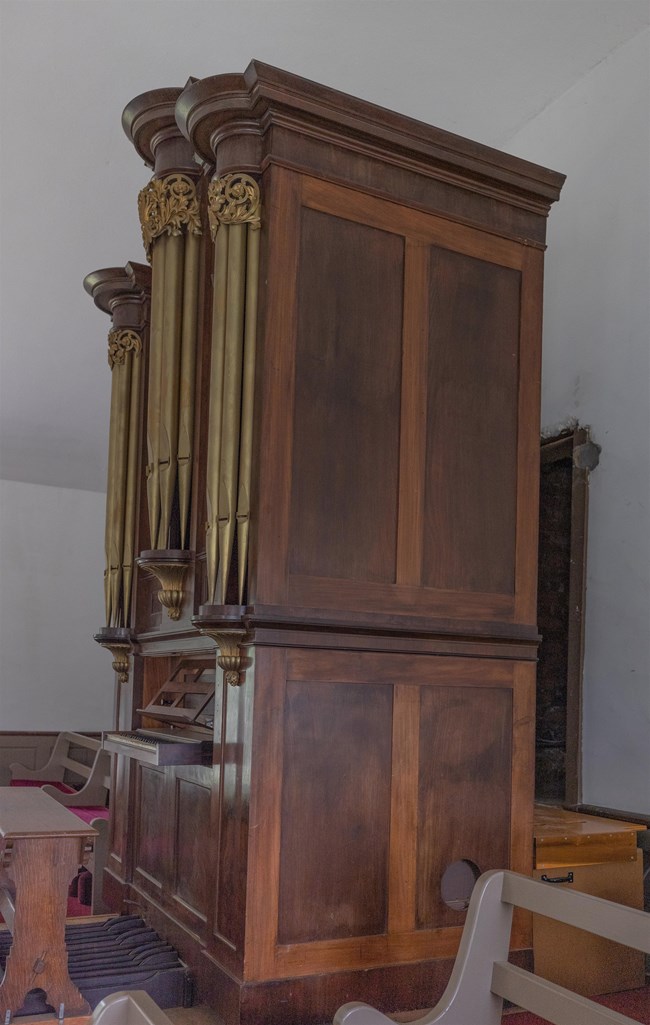Last updated: July 1, 2021
Article
The Historic Erben Pipe Organ at St. Paul's

National Park Service
The Historic
Erben Pipe Organ at St. Paul's
The small, brown mahogany case pipe organ resting comfortably at the center of the gallery of St. Paul’s preserves an interesting chapter in the history of the site. It also reflects the history of the place of music in the American Protestant church and the craftsmanship of New York’s premiere 19th century organ maker.
Melodious organs are today a common fixture in Protestant churches, but that was not always the case. Following the Reformation of the 1500s, organs were characterized by many Protestant leaders as too closely tied to the Roman Catholic Church, even vestiges of paganism and superstition which interfered with authentic religious experiences. Sources of intense controversy in European Protestant circles, organs were removed and banned from many churches. Puritan congregations in colonial America, including the parish that established St. Paul’s in 1665, eschewed them. Singing of psalms, unaccompanied by music, was the acceptable form of worship, supplemented by a tuning fork in the early 19th century.
The introduction of the organ at St. Paul’s in the mid 1830s corresponded with a pattern of the gradual acceptance of instruments as a vital part of worship. A movement begun in England, often called the Oxford movement, which affected Episcopal churches across America, stressed a return to elements of the Christian heritage that had been omitted during the Protestant Reformation, including organs. Originated in Anglican churches in England, the Oxford movement, sought a more powerful emotional symbolism, energy and mysticism in church worship, achieved in part through musical accompaniment for singing hymns.
The new organ also reflected a pattern of a wealthier parish. George Rapelje, son of an original St. Paul’s congregant, contributed the $800 in 1833 necessary to purchase the instrument. In today’s money, that would be about $17,600; or, products that today cost $800 would have cost about $38 in 1833. Wealthy merchants and builders living near what is today Co-Op City in the northern Bronx, the Rapeljes are buried in the historic cemetery at St. Paul’s. And, when the church, through the Rapeljes, finally invested in an organ, they chose the best -- an Erben.
Born in 1804 in New York City, Henry Erben was the son of Peter Erben, for decades the organist at famed Trinity Episcopal Church on lower Broadway in Manhattan. Henry Erben established an organ making concern in the 1820s, and his ultimate output of more than 800 pipe organs found homes ranging from small residences to large cathedrals across the United States as well as Central and South America. Pugnacious and strong-willed, Erben was a master craftsman who considered each organ leaving his shop as a personal statement on his worth as a builder. A bold businessman before police and security were well developed, when physical bravery was an important asset for a successful entrepreneur, Erben clashed, sometimes physically, with neighbors, rivals and street toughs aligned with machine politicians. Carefully constructing instruments in his factory at 88 Centre Street when he produced the St. Paul’s organ, Erben’s operations were struck several times with arson and industrial sabotage; but he relocated to other lower Manhattan buildings and returned to the enterprise of producing the finest organs of his day.
The St. Paul’s instrument is one of the nation’s oldest functioning pipe organs still in its original setting. Modeled on English instruments of the late 18th century, the smaller Erben organs were designed to blend tonal characteristics of warmth, subtlety and clarity. Eighteen foot pedal keys triggering lower register notes were added in the 1800s and an electric blower was installed in the 20th century to power the bellows process; but other than those additions, the stately looking instrument, including the entire action, is original. . The 58 key notes, GG, AA to f3, are covered with ivory. Eight draw knob, ivory covered stops with square shanks frame the keys, arranged vertically; names of the stops are engraved in script. Twenty-seven half round wood dummy pipes decorate the façade. In 2000, the St. Paul’s Erben organ was recognized by the Organ Historical Society “as an instrument of exceptional historical merit, worthy of preservation.”
From the mid 1830s through the late 1970s, organ music was an important ritualistic part of worship at St. Paul’s, and Franklin D. Roosevelt who visited in the 1930s, among others, enjoyed its sweet sounds. The organist in 1861, O.W. Street, joined the Union army, but as a show of support the vestry, the church’s ruling council, voted to continue his weekly salary of $4. Donald R.M. Paterson, who was raised in Eastchester, played the organ for wedding celebrations as a teenager in the 1940s. This musical experience generated an interest in 19th century organs, and Paterson went on to a distinguished career as an organ historian, performer and professor of music at Cornell University. Charles Reid served as organist for the final 33 years of the active parish and performed some concerts in the mid 1980s when St. Paul’s opened as a national historic site.
There was a period of neglect of the organ in the 1980s and 90s. Fortunately, efforts to preserve and increase appreciation of the instrument’s significance and value were revitalized in the late 20th century by Edna N. Schloton, who was the Dean of the American Guild of Organists, and Henry A. May, a researcher who lived in Mt .Vernon. Careful stabilization work has been carried out over the past 20 years. Even now, nearly 190 years after the Erben was placed in the church gallery, visitors appreciate the sounds and history of the instrument through recitals by St. Paul’s Concert Organist in Residence Kathryn Jones, who is the organist at nearby Huguenot Church of Pelham, New York.
